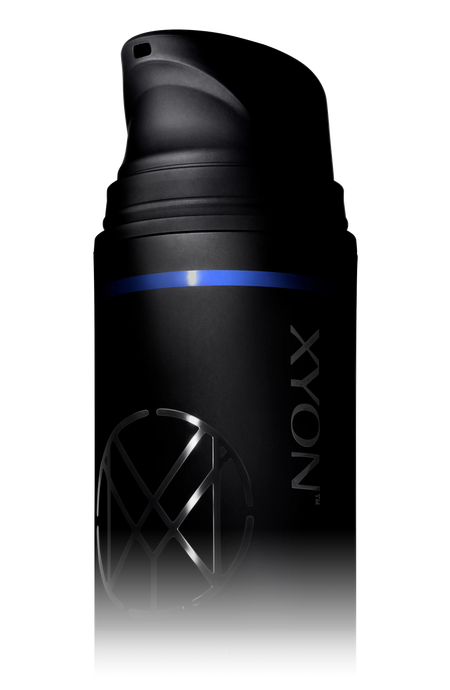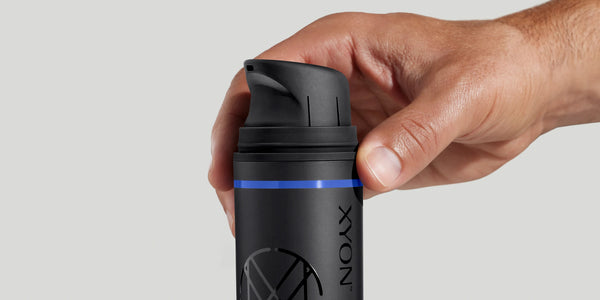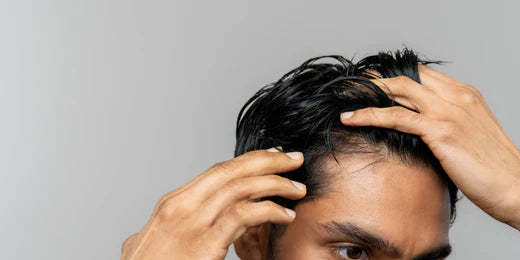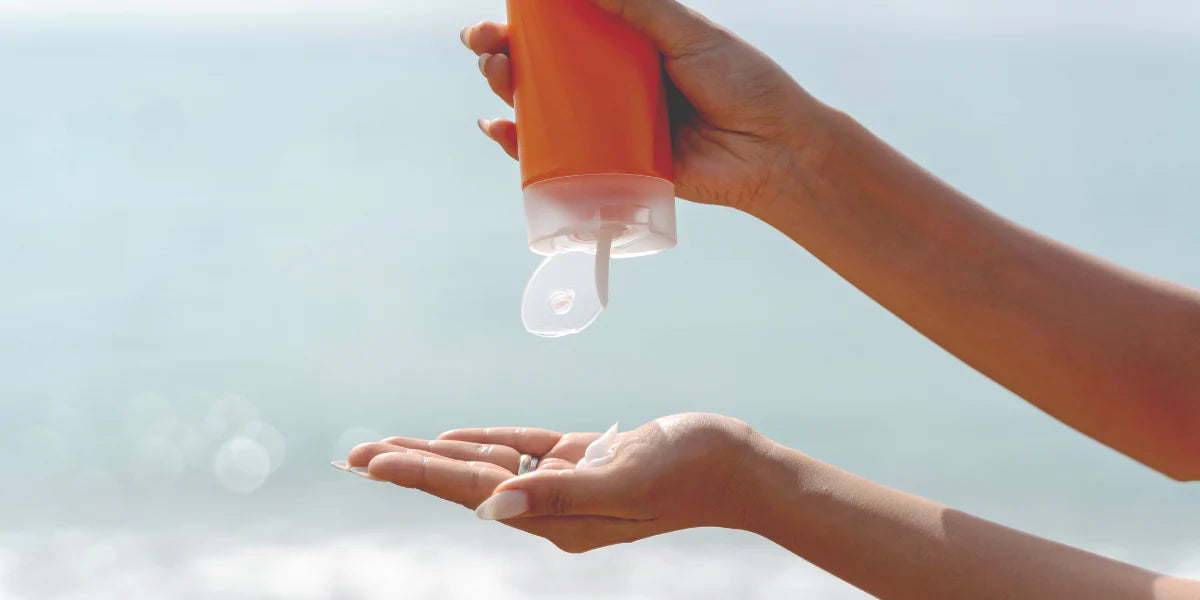Dealing with hair loss can be difficult and trying to find the most effective treatment isn’t always straightforward. Rogaine®, available over the counter and Propecia®, which is a prescription medication for hair loss, are popular options when deciding to start treatment. There has been research done on combining these two medications, but how safe is this? And is using minoxidil while taking finasteride actually more effective?
We’re going to delve into the advantages of using minoxidil while taking finasteride and explain the options available when it comes to combining your hair loss medications. Dr. Christina Han, a board-certified dermatologist and Medical Director at XYON, also gives her expertise on the topic.


Already fighting your hair loss? Take things to the next level
If you're already trying finasteride or minoxidil and seeing results, combining the two can get you even more hair! Try our topical fin + min!
What is finasteride?
Finasteride, the generic name for the drug Propecia®, is a prescription medication for hair loss. Approved by the FDA and Health Canada in a 1mg oral dose, finasteride tackles hair loss by blocking the effects of dihydrotestosterone (DHT). More specifically, finasteride prevents an enzyme called 5-alpha reductase from converting testosterone into DHT, helping to lower DHT levels at the scalp. This helps stop the shrinking of hair follicles at the scalp, which is the process that leads to the production of weaker hairs and eventual balding in pattern hair loss (androgenetic alopecia).
Although only formally approved as an oral treatment, finasteride may also be prescribed off-label as a compounded topical solution, following a consultation with a doctor or hair loss specialist.
What is minoxidil?
The other medication you’ll come across when looking for hair loss solutions is minoxidil and this is the active ingredient in Rogaine®. Minoxidil is approved by the FDA and Health Canada as a topical solution in 2% or 5% concentrations, but it may be prescribed off-label as an oral tablet. It has a different way of working for hair loss, acting more directly on the hair follicle. Previously developed as a medication to treat high blood pressure, minoxidil widens blood vessels in the scalp, improving blood flow to hair follicles which supports healthy hair growth. It’s also thought to positively influence the hair growth cycle by pushing more hair follicles into the active growth phase sooner and keeping them in this phase for longer (Messenger & Rudegren, 2004).
Benefits of using minoxidil while taking finasteride
Growing research is suggesting that a combination approach to your hair loss treatment may be the most effective option, but why is this?
Well, we know that finasteride and minoxidil work in different ways, so combining them may target more than one aspect of hair loss. Minoxidil has a more direct effect on the hair growth cycle, whilst finasteride works to tackle the root cause of hair loss and slow the hormonal mechanisms responsible for the shrinking of follicles. Supporting research for this approach has found superior hair growth improvements in those using finasteride and minoxidil together, with 94% of participants showing improvement at 12 months (Hu et al, 2015). This was a male-only study, but similar research on participants with female pattern hair loss found that a combination treatment of topical finasteride (0.25%) and topical minoxidil (3%) was significantly superior to topical minoxidil alone (Suchonwanit et al, 2018). This demonstrates that combining finasteride and minoxidil may be the most effective treatment option for both male and female pattern hair loss.
Another thing of note is that minoxidil may help treat hair loss in cases where androgens aren’t the sole contributing factor. For example, minoxidil has been shown to be effective for hair loss caused by stress (i.e., telogen effluvium) (Arck et al, 2003). Given that hair loss is so often multi-factorial, minoxidil may be a beneficial addition to your treatment.
Can I use minoxidil once a day while taking finasteride?
If you’re already taking finasteride but haven’t achieved the results you were hoping for, you might be considering adding minoxidil to your treatment. But is this safe to do?
For many people, minoxidil and finasteride can be safely used at the same time, since there are no known drug interactions between finasteride and minoxidil and they work in different ways. In fact, it may even be recommended to improve the results of your treatment. However, it’s important to discuss any potential changes to treatment with your prescribing doctor.
The idea of adding another medication into the mix to get better results out of your treatment may sound appealing, but the reality of it can be inconvenient. Remembering to take a tablet every day can be difficult for some and on top of that, having to apply a cream each morning might feel like more hassle than it's worth. The concern of experiencing side effects can also be a contributing factor that may deter people from taking two medications at once.
If this resonates with you, you might want to consider a combination therapy incorporating both medications in one treatment and more specifically, a topical medication if you’re looking to minimize the risk of side effects. At XYON, we offer a topical treatment containing minoxidil and finasteride compounded in our SiloxysSystem Gel™ which is designed to potentially limit bloodstream absorption of the medication to reduce the risk of potential side effects. There’s a variety of options available when it comes to combining treatments and speaking to a hair loss specialist can help you to make an informed decision in finding the treatment that’s best suited to you.
Can I stop using minoxidil if I start taking finasteride?
If you’ve used Rogaine® (or another form of topical minoxidil) for a while but you’re thinking of starting finasteride, is it worth keeping up with your topical treatment as well?
We asked Dr. Han to weigh in and she reminded us that even if you don’t see any regrowth with minoxidil, no further progression of hair loss is still considered a successful treatment. If this is the case for you, here’s what Dr. Han recommends:
“I would typically advise my patients to continue their minoxidil treatment and add finasteride in conjunction, to try and further boost hair regrowth. However, if you are still experiencing progression of hair loss after being on minoxidil for at least a year, it would be reasonable to consider switching to something like finasteride.”
Ultimately, it's up to you to decide. Some people who replace minoxidil with finasteride won’t have any issues, but it's important to understand your options. Minoxidil will only work for as long as you are using it, so when you stop applying minoxidil you will likely experience hair shedding again. If you choose to replace your topical minoxidil with oral finasteride, there may still be a small risk of shedding in the first few weeks after switching treatments, but this should stop on its own.
Do minoxidil and finasteride cause erectile dysfunction?
A common concern when it comes to hair loss medication is the risk of sexual side effects. As Dr. Han told us, “Sexual side effects are not expected with minoxidil, but can occur with finasteride.” Whilst this can be a concern, the incidences are fairly low. To put it into perspective, a comprehensive review looking at 73 studies revealed that finasteride was ‘infrequently’ associated with problems relating to ejaculation, erection and libido (Carbone Jr & Hodges, 2003).
Dr. Han explained why some people will experience side effects:
“Finasteride doesn’t always just affect DHT levels at the scalp and it can sometimes suppress the DHT levels in the genito-urinary system. As a result of this, a small percentage of men can experience decreased libido, decreased ejaculate volume and erectile dysfunction.”
When it comes to combining minoxidil and finasteride, there doesn’t seem to be any evidence to suggest that it makes your risk of side effects higher. Dr. Han gave her input:
“There haven’t been any studies to suggest that taking minoxidil and finasteride in combination will perpetuate side effects. In fact, treating hair loss with a combination of finasteride and minoxidil is a common practice done by physicians and specialists around the world.”
Does topical finasteride and minoxidil have side effects?
Like most medications, there’s a risk of side effects when using topical finasteride and minoxidil. The most common side effects include:
- Itching, irritation and redness on the scalp
- Burning sensation
- Dry and flaky scalp
Absorption of finasteride into the bloodstream can cause sexual side effects, such as erectile dysfunction, whilst absorption of minoxidil can cause dizziness associated with low blood pressure. Opting for a topical formulation of your medication can substantially reduce the risk of these side effects occurring.
By choosing a topical solution instead of an oral pill, you may be able to limit the amount of active ingredients absorbed into your bloodstream and this can help to reduce your risk of side effects. But within the topical hair loss medication space, there are numerous options available that vary in their composition and some products will result in higher levels of systemic absorption than others. This is why it’s important to do your research and consider what your options are alongside a doctor or other healthcare professional.
The takeaway on using minoxidil with finasteride
When it comes to treating your hair loss, you want a solution that works. Growing evidence suggests that a combination of minoxidil and finasteride could be the answer and there are various forms that this can take. It will ultimately come down to your preference and risk tolerance for side effects. Opting for a topical solution that incorporates both minoxidil and finasteride in one, is a great option for both convenience and lowering your risk of side effects, whilst still getting the hair growth benefits of a combination therapy. Ready to take the next step? Connect with a hair loss specialist through XYON today to find out the best treatment options for you.
References:
Arck, P.C., Handjiski, B., Peters, E.M.J., Hagen, E., Klapp, B.F., Paus, R. (2003). Topical minoxidil counteracts stress-induced hair growth inhibition in mice. Experimental Dermatology, 12(5), 580-590. https://doi.org/10.1034/j.1600-0625.2003.00028.x
Carbone Jr, D.J., Hodges, S. (2003). Medical therapy for benign prostatic hyperplasia: sexual dysfunction and impact on quality of life. International Journal of Impotence Research, 15(4). https://doi.org/10.1038/sj.ijir.3901017
Hu, R., Xu, F., Sheng, Y., Qi, S., Han, Y., Miao, Y., Rui, W., Yang, Q. (2015). Combined treatment with oral finasteride and topical minoxidil in male androgenetic alopecia: a randomized and comparative study in Chinese patients. Dermatologic Therapy. https://doi.org/10.1111/dth.12246
Messenger, A.G., Rundergren, J. (2004). Minoxidil: mechanisms of action on hair growth. The British Journal of Dermatology, 150(2), 186-194. https://doi.org/10.1111/j.1365-2133.2004.05785.x
Suchonwanit, P., Srisuwanwattana, P., Chalermroj, N., Khunkhet, S. (2018). A randomized, double-blind controlled study of the efficacy and safety of topical solution of 0.25% finasteride admixed with 3% minoxidil vs. 3% minoxidil solution in the treatment of male androgenetic alopecia. The Journal of The European Academy of Dermatology & Venereology, 32(12), 2257-2263. https://doi.org/10.1111/jdv.15171




